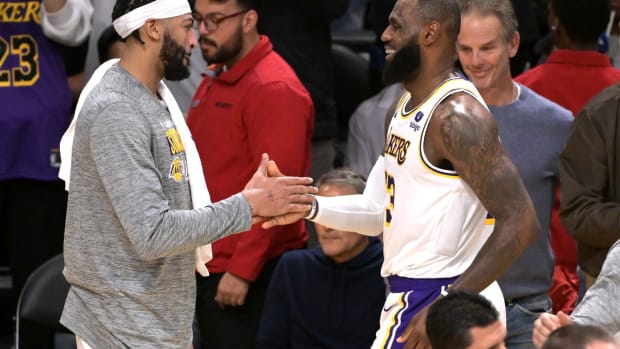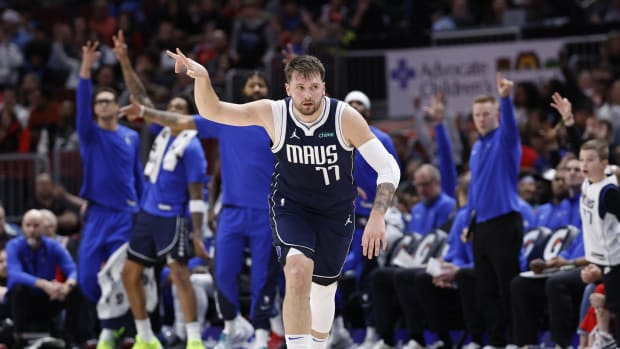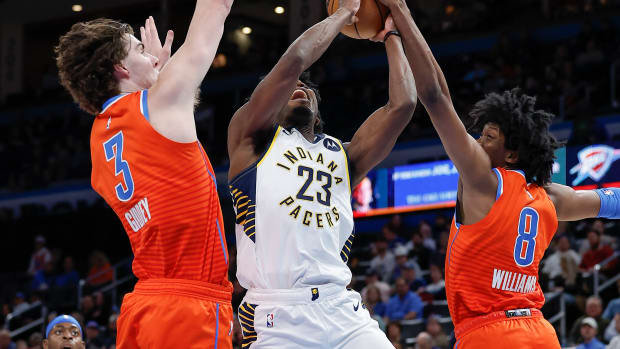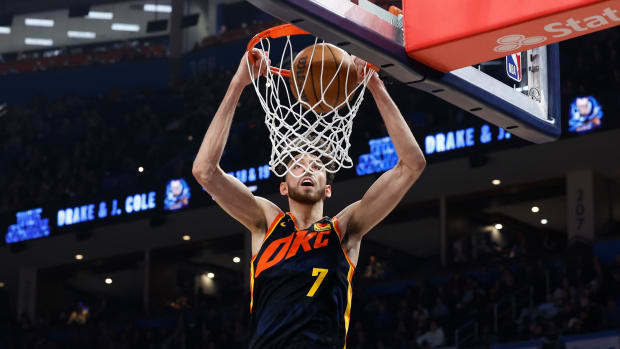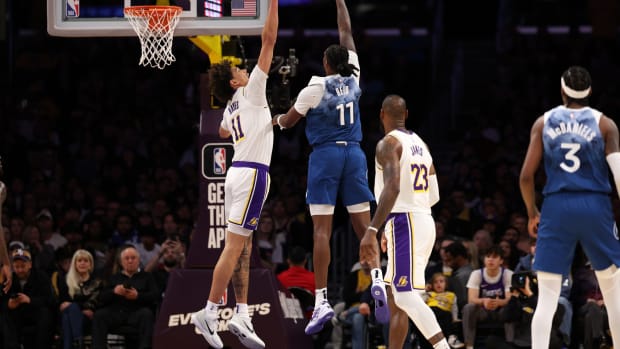Is the NBA Headed for Extreme Small Ball?
The Warriors' dominance triggered a mad scramble in the NBA this offseason, with potential contenders trying to stockpile stars and two-way talents in hopes of keeping up with the reigning champions.
Even LeBron James and the Cavs are tinkering a bit, putting an even bigger premium on shooting and appearing to punt defense altogether. That trend continued with the team announcing Kevin Love would start the year at center, relegating Tristan Thompson to the bench and surrounding James with as many shooters as possible in the starting five.
With the Warriors and Cavs both trending smaller and reaching the Finals the last three years, it's no surprise that other teams around the league are attempting to follow their blueprint. Only problem? It's not that easy.
On the latest episode of Open Floor, Andrew Sharp and Ben Golliver discussed this league-wide trend and examined whether "extreme small ball" is the future of the NBA.
(This transcript has been edited and condensed for clarity.)
Andrew Sharp: Earlier this week you said we could see more extreme small ball than we’ve ever seen before, and I’m curious, because Kevin Love at center is pretty extreme. Explain yourself.
Ben Golliver: I just think it’s sort of a natural evolution. What we see during the Finals a lot are these lineups where basically it’s just 10 guys who are listed at 6’9” and shorter. You basically have Kevin Durant and LeBron James as the functional centers. And when you have talent, especially scoring talent, I think the smaller you go—and the more often teams are finally admitting that big isn’t working—you have a better chance of just running teams off the court. You play faster and score more by getting as many shooters as possible on the floor. The best lineups from an efficiency standpoint for Cleveland last year were just LeBron plus as many shooters as possible. Take any non-shooter off the court, and they’re good to go.
And I don’t think Cleveland and Golden State are the only two teams to figure this out. I think Boston is going to have figured this out, and Houston after all of the offseason moves they’ve made. They can play big and use a guy like Clint Capela in a DeAndre Jordan-like mold, but I think they’re also going to be able to get out their with five guys who are 6’9” and shorter—and all of them can shoot and all of them can play five feet behind the three-point like. And I think they’re going to blow teams’ minds. Because if you’re matching up with them, you’re going to have to make a lot of tough decisions and you’re not going to be able to keep a center on the court. I think it’s just this copycat natural evolution, where the league keeps getting smaller and smaller. I hope this is where the NBA is going. Some people might say, “Oh, it looks more like soccer—“
Sharp: And I think that would be a good thing for the sport! I think it’s only going to make basketball more entertaining as you take some of the less-skilled guys off the court, and that’s kind of what I’m curious about. Will we look back in 10 years and be amazed that a dude like Andre Drummond was ever getting 35 minutes per game? Will big men come off the bench like specialists? Like a Hannibal Lecter situation? Where you a bring a guy in for 15 minutes and everyone just gawks. But beyond that everyone is just 6’8”. I’d be into that!
Golliver: I think that’s where we’re headed. And at the highest level, that’s where it’s been. The best teams, Golden State for example, they throw ZazaPachulia out there just to kind of butter you up. To soften you up.
Sharp: [Laughs] It almost feels like they’re just trying to be diplomatic about it and then they take him out after five minutes.
Golliver: Totally! And then they drop the pretenses and they put five guys in who are all playmakers and can all play defense. And the problem is no one around the league also has five offensive playmakers who can also play defense. That’s the big issue we’ve got right now. But teams are trying to get there. You look at the true contenders and they are going in that direction. They are trying to get as many playmakers who can also hold their spot defensively. And that is the ideal world, where everyone can do something with the basketball, it’s not just catch-and-shoot specialists, they can also spot-up and attack. And I think we’re getting to the point where the talent has started to aggregate on so few teams that there are going to be some interesting head-to-head matchups this season, and there are going to be a lot of teams that just have no chance when elite teams go to these deadly lineups.
Sharp: Speaking of no chance, the only other thing I wonder about when you lay this out, is what do you do with a guy like Karl-Anthony Towns? How do they fit into this system? Because Towns is a freak, and he belongs on the floor for 40 minutes regardless.
Golliver: Yeah. I don’t know if you remember when we did a piece on “What will the NBA look like in 2020?” and I jokingly said Mike D’Antoni will coach Towns and Towns will be the point guard. But, he’s a shooter, he’s a playmaker, he can put the ball on the floor and attack from the three-point line. Karl Towns is fine. What he needs to figure is out is defense. Can he protect the rim? That’s what he needs to work on. Joel Embiid is already there on defense, and he’s comfortable around the three-point line too. He can beat you basically anywhere. There are going to be a few guys that can still punish, and you aren’t going to have any chance to defend with a 6’8” forward. But if you don’t have three-point range, it’s going to be really tough for a lot of these centers to remain relevant. That’s why they call these guys unicorns. If you’re someone like Myles Turner, you have to get that three-point shot locked in. f you really want to be the type of perennial All-Star-type player that your talent says you should be, you have to have a knockdown three-pointer.
Sharp: That’s what I wonder about. In theory, this should make the unicorns more valuable than ever. Maybe the most valuable players on the court. But we haven’t really seen that yet. Because Steph Curry is still the most valuable player on the court in the Finals. OK, LeBron is in mix too. I shouldn’t go overboard.
Golliver: Yeah… LeBron was definitely No. 1.
Sharp: Yes, OK, definitely No. 1. But, it’s still super perimeter-oriented at the top of the league. Of the 10 most valuable players, seven are guards. And I wonder if that’s going to shift. We’ll have to wait and see! We just haven’t seen many of the unicorns translate to much winning. Even someone like Anthony Davis, KristapsPorzingis, Towns… I wonder when we’re going to turn that corner.
To hear more from Andrew Sharp and Ben Golliver, subscribe to the Open Floor podcast on iTunes.































